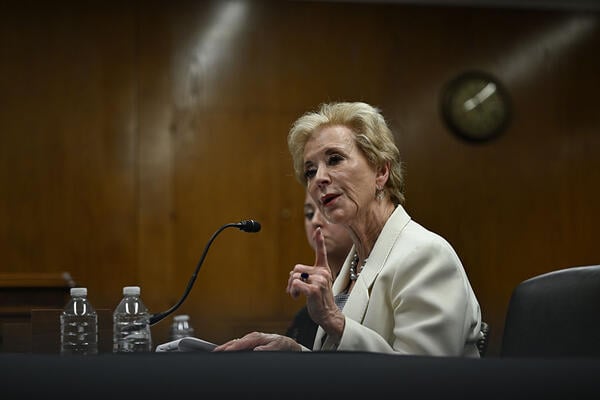
Trump Gutted IES. Skepticism of Its Renewal Abounds.
Soon after Donald Trump returned to the White House, his administration gutted the federal government’s central education data collection and research funding agency, the Institute of Education Sciences. Researchers say the move jeopardized the nation’s ability to figure out how to improve K–12 and higher education and its capacity to hold publicly funded schools, colleges and universities accountable.
But the president didn’t fully erase IES—which Congress created, and continues to require to exist, through the Education Sciences Reform Act of 2002. And officials at the Education Department maintain that the Trump administration is committed to supporting “a national education research entity.” But months later, it’s hard to ascertain what the agency’s future will be.
In the eight months since the Department of Government Efficiency and the Education Department announced the slashing of more than $1 billion in multiyear contracts administered by IES, there have been mass layoffs followed by some new job postings; litigation over canceled studies and contracts, followed by reports of some restorations; a request for public comments about how to “modernize” IES, despite the administration’s continued push to shutter the department housing it; and Education Secretary Linda McMahon’s temporary appointment of a special adviser to “re-envision” IES, who must now finish her work amid a government shutdown.
Adding to the confusion, Congress is planning to provide at least $740 million to IES for fiscal year 2026, despite the administration only requesting $261 million for the agency.
“It’s a very confusing time,” said Beth Tipton, president of the Society for Research on Educational Effectiveness and a statistics and data science professor at Northwestern University. “It’s a lot of very mixed signals.”
Concepts of a Plan
Michael J. Petrilli, president of the Thomas B. Fordham Institute, a conservative-leaning, education-focused think tank, said the big challenge for Amber Northern, the special adviser tasked with reforming IES, “was that DOGE came in and burned it to the ground.”
He said Northern, who is on leave from the Fordham Institute, has been on listening tours with university-based scholars and others about how to reform IES, but he and others worry her efforts won’t ultimately come to fruition.
Petrilli added that he believes Northern has support from McMahon, but he questioned whether the White House Office of Management and Budget would be willing to fund whatever plan Northern comes up with—even though it should be Congress’s job to decide what to fund.
He said he thinks “everybody in the world of education research and statistics would say that IES was not working perfectly, far from it.” But, “if we’re still a law-abiding republic,” it’s hard to reform IES without Congress stepping up to revise the Education Sciences Reform Act, he said.
Mark Schneider, IES director during the Biden administration and part of Trump’s first term, has publicly criticized IES’s performance. But he said the layoffs left IES with few people to supervise the dollars still flowing in. And he noted Northern has only two months left in her appointment to issue her report, but the government shutdown that began Oct. 1 means a lack of staff to analyze the public comments on the request for information.
“Everybody I talk to in the administration says they’re working on a plan and they will soon make it available,” he said. But, “right now, it looks way too chaotic.”
He said the Trump administration’s cuts to IES make it easier to implement a new vision, so he remains optimistic. “I just wish that the plan was further along.”
Tipton said everyone she knows who has interacted with Northern thinks she’s a serious scholar, but wondered, “Is anybody going to listen to the plan that Amber puts together?”
The plan could be an expansion of what IES has been doing—or a retrenchment. Josh De La Rosa, the director of annual reports and information staff at IES until the Trump administration laid him off, said IES’s typical every-four-years test of 9-, 13- and 17-year-olds has been canceled, alongside another long-term study of groups of ninth graders’ progression through high school into higher ed and the workforce. Those cuts raise questions for De La Rosa about whether the department is just planning to fulfill its statutory obligations. (The Education Department said Tuesday that NCES will be releasing the 2025 assessment reports for 9- and 13-year-olds in 2026 as planned.)
“Do they want to stay at the legal minimum that the law requires, or do they want to meet the demands of the data users?” said De La Rosa, who remains a board member of the Association of Public Data Users.
Paige Kowalski, executive vice president of the Data Quality Campaign, a policy and advocacy organization that promotes education data access, said she thinks department staff and leaders really are seeking a plan to more efficiently and effectively meet the congressional requirements for IES. But, “I can’t reconcile that with layoffs and the executive order to dismantle the department at the same time.”
They’ve got to figure out a way to make sure that the work they’re doing is on target with what educators and policymakers actually need, the topics that they’re studying, the problems that they’re trying to answer. And too often it’s not.”
—Michael J. Petrilli, president of the Thomas B. Fordham Institute
Kowalski said she thinks the department is trying to see whether IES functions can be moved outside the department, as it has done with other offices. In its efforts to shut down the department, the Trump administration has transferred career and technical education programs to the Labor Department, and some outside experts and groups have proposed moving IES to another federal agency.
The Education Department did not provide an interview for this article or answer specific questions.
How IES Crumbled
In February, the Trump administration announced it had canceled nearly $900 million in contracts awarded by IES—a move that alarmed education researchers and other groups. A couple of days later, it canceled $336 million worth of contracts with IES-administered Regional Educational Laboratories and a further $33 million of grants to Equity Assistance Centers.
Then, the federal government slashed IES itself.
The administration laid off nearly half of the employees at the Education Department, including almost the whole workforce of the National Center for Education Statistics. NCES is a significant part of IES that houses the Integrated Postsecondary Education Data System, or IPEDS, and the connected College Navigator website, which parents and prospective students can use to research colleges they’re interested in. Former employees reported that the government-gutting DOGE cut the NCES head count from 100 to three.
One lawsuit challenging the IES cuts claimed about 90 percent of all staff at IES had been laid off.
While the department fights the lawsuits, there have been multiple signs of life at the agency, most notably the May announcement to hire Northern, senior vice president for research at the Fordham Institute, to “lead a process to reenvision IES.”
Severe staff shortages continue to threaten data quality, slow research progress and undermine public trust.”
—Tabbye Chavous, executive director of the American Educational Research Association
The Institute for Higher Education Policy, which sued over the cuts, said that, in June, IES reinstated the terminated 2024 National Postsecondary Student Aid Study, again providing “crucial insights on affordability, student enrollment and on-campus experiences that are not available through any other sources.” The group also said IES reversed its decision to end researchers’ remote access to restricted education data sets and reinstated the support contract for DataLab, an online platform that allowed easy access to and custom analysis of IES data.
IES eventually posted job applications for some positions related to the National Assessment of Educational Progress—a long-running test of students in a few K–12 grade levels dubbed “The Nation’s Report Card,” which is relied upon by researchers for comparable state-to-state data on student progress. And at the end of September, the department requested comments on how it should “modernize” IES to ensure its core functions “maximize relevance, timeliness, and usability for the education stakeholders who rely on them.” The comment period ended last week; more than 400 comments were submitted.
Tabbye Chavous, executive director of the American Educational Research Association, wrote in an email to Inside Higher Ed that “in recent weeks, we’ve seen limited but welcome progress: the posting of job announcements to support NAEP, the release of previously frozen research grants, and the approval of modest new funding.”
Chavous noted that while NCES is working to update surveys and data collections, “severe staff shortages continue to threaten data quality, slow research progress and undermine public trust.”
Diane Cheng, vice president of policy at IHEP, said the positions posted for hires don’t support NCES’s other data-collection efforts beyond the National Assessment of Educational Progress.
“We’re deeply concerned that whatever the department is planning is not going to support the depth, breadth and scope of education data and research that the country needs,” Cheng said.
Cheng added that the laid-off staffers understood what was required “to maintain the statistical rigor, the data quality, the privacy protections, how you effectively collect data from colleges and students.”
“Without those staff, without resources, it’s not clear how the department is gonna make sure that the federal data collections continue to best support students, researchers, institutions and policymakers,” she said.
In a statement to Inside Higher Ed, Education Department officials reiterated previous complaints about IES and offered no concrete details about their plans for the agency.
“Despite spending hundreds of millions in taxpayer funds annually, IES has failed to effectively fulfill its mandate to identify best practices and new approaches that improve educational outcomes and close achievement gaps for students,” the statement said. “The Trump Administration is committed to supporting a national education research entity that delivers usable, high-quality data and resources.”
The department said it found IES contracts with indirect cost reimbursements of over 50 percent, and that it’s reduced the cost of the National Assessment of Educational Progress’s core contracts by more than 25 percent, saving about $185 million over five years.

Education Secretary Linda McMahon is overseeing an effort to close the Education Department.
Celal Gunes/Anadolu via Getty Images
How to Rebuild IES
Education policy and research advocacy organizations and former leaders of IES do agree that the agency could improve, and they want to see some changes. They hope they’re actually made, rather than IES remaining moribund.
“Everyone agrees that we need more timely data and more relevant data,” said De La Rosa, the former IES director of annual reports and information staff. “But to unpack why it’s not timely is important.”
He said COVID and other events have expanded data users’ needs.
“What has not kept pace with that is any investment into research,” he said, adding that IES doesn’t have the capacity following the staff cuts to be more timely.
Tipton, of the Society for Research on Educational Effectiveness, said the questions the department asked in the request for comments on IES’s future made her think it could become “a stronger IES that’s more rooted in the needs of schools and communities.” She said the previous IES was scientifically strong, but its one weak spot was “the last mile,” or “how do we actually get this information out? How do we engage?”
Schneider, the former IES head, said IES’s longitudinal studies are very expensive, but faculty complain when getting rid of them is proposed, saying their graduate students depend on them to write dissertations. Petrilli, of the Fordham Institute, said IES’s “contracts are often super expensive” and “take forever.”
Further, Petrilli said, “they’ve got to figure out a way to make sure that the work they’re doing is on target with what educators and policymakers actually need, the topics that they’re studying, the problems that they’re trying to answer. And too often it’s not.”
Christine Keller, executive director of Association for Institutional Research, said some IES studies had actually been underfunded for years, and results had been taking longer to release. She suggested fixing that.
“If we don’t have the data, it’s really hard to know what’s working and what’s not,” Keller said.
Kowalski, of the Data Quality Campaign, said, “There are opportunities now, in light of how states are starting to think about better aligning ed and labor, to think about the fact that NCES was so education-focused and it wasn’t keeping up with where states are and the questions that they’re trying to answer.” She also said the federal government was operating off 20-year-old data and research practices.
“Maybe it will lead to something better in the future as they rebuild,” Kowalski said. “It’s just really too soon to know.”
Source link


